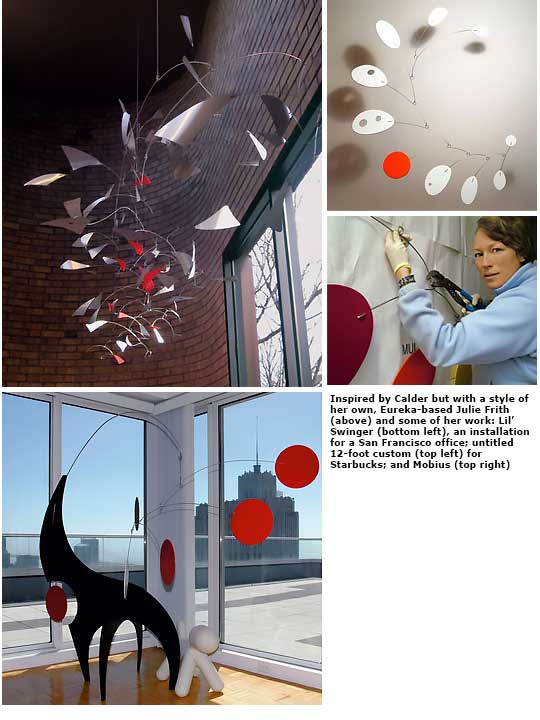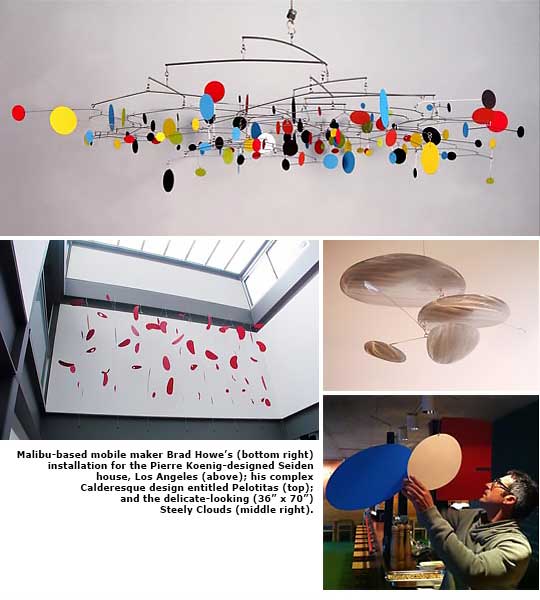Art in the Air - Page 3

Later mobile artists of note include Timothy Rose of Sausalito and Jerome Kirk, who settled in Healdsburg.
Meanwhile, many advances were made in the much broader field, 'kinetic art,' which ranges from mechanically controlled robots to electronics and sound sculptures.
One of the world's most unique creators of mobile sculptures is San Franciscan Ruth Asawa, whose freeform, basket-like wire designs, which she began in the 1950s, have become iconic. Asawa was married to architect Albert Lanier, who designed mid-century modern homes.
The connection between mobiles and mid-century modern design is acknowledged by many current mobile makers. "A lot of my clients come from that mid-century modern mindset," Matt Richards says.
When Schmitt heard a tour of modern homes was planned for Sacramento last year, he scurried to sign on as a sponsor and 'gifted' a mobile to Graham and Foster, whose home was on the tour.
"The style is timeless, clean design," Schmitt says of mid-century modern. "That's how I'm trying to approach my own aesthetic."
If anything haunts the otherwise joyful world of the contemporary mobile maker, it's the ghost of Calder.
Too many people, Julie Frith says, "they think, if it's a mobile, somebody has copied Calder. No, that's not what it is."
Frith, a "100-percent mobile maker" who's been turning them out for 12 years since being floored at a Calder exhibit, insists she's no copyist. "I want to be different from Calder and from everybody else."
Richards too acknowledges the influence. "I cut my teeth on pieces reminiscent of Calder," he says. "When I get the opportunity I like to try something new."
"To me," Howe says, "mobiles don't belong to Calder. Calder was just a virtuoso in the mobile world. Calder didn't invent them and he didn't own them. He pushed the science of mobiles in a lot of different directions."
Science?
"There a quasi-physics to it," architect Zoltan Pali says with a laugh. "A crazy physics."

Ever since Calder, who would often build several models for each sculpture to get the movement just right, artists have twisted, tied, weighted, and otherwise manipulated their works' hanging elements to get the balance and movement just right.
It is how a mobile moves, as much as its appearance, that defines its style.
That's why so many mobile artists began as engineers -- and why Matt Richards collaborates with Ben Cogdill, his in-house industrial designer.
"It has to work. It has to turn," Julie Frith says. "It has to move nicely, to be graceful."
Mobiles, originally mostly metal, today come in plastic, paper, and in a few cases, wood. Schmitt, who uses bamboo and various woods, plans a new line in metal -- and perhaps one in felt.
Metals used range from stainless steel to aluminum, to various combinations. Connections vary too.
"Some mobiles by artists are more Calder-style, using bent wire with paddles," Schmitt says. "Others are connected with rings that limit the motion, so you know the pieces will stay in relation to others in a certain way.
"I strive for every piece to have full 360-degree rotation. I think it makes a more interesting piece."
Getting the right balance isn't easy, Schmitt says. "That's a little bit of a trade secret. It's part of the mystery."
"I can only approach it knowing the elements look good together," he says, "and as they spin it's going to be a fun effect."
At the end, science gives way to art -- which is another serendipitous thing about the art of mobiles.
"You may start with the basic idea," Howe says, "but once in process, a lot of unexpected things occur. The original idea morphs."
"When working on a piece," he adds, "you end up having all these spontaneous new ideas burst out in front of you. So when you're done, you have ten new directions to work in. And each one of them inspires ten more directions.
"It's a self-propelling experience. You end up with more ideas than you could possibly accomplish in a lifetime."
Photos: David Toerge, Carl Van Vechten, Dave Weinstein, Paulo Tavares Pereira, Chris Schroeer-Heiermann, David Zuttermeister; and courtesy Brian Schmitt of Schmitt Design, Heather Frazier of Frazier & Wing, Julie Frith, Brad Howe, Matt Richards of Ekko Mobiles




